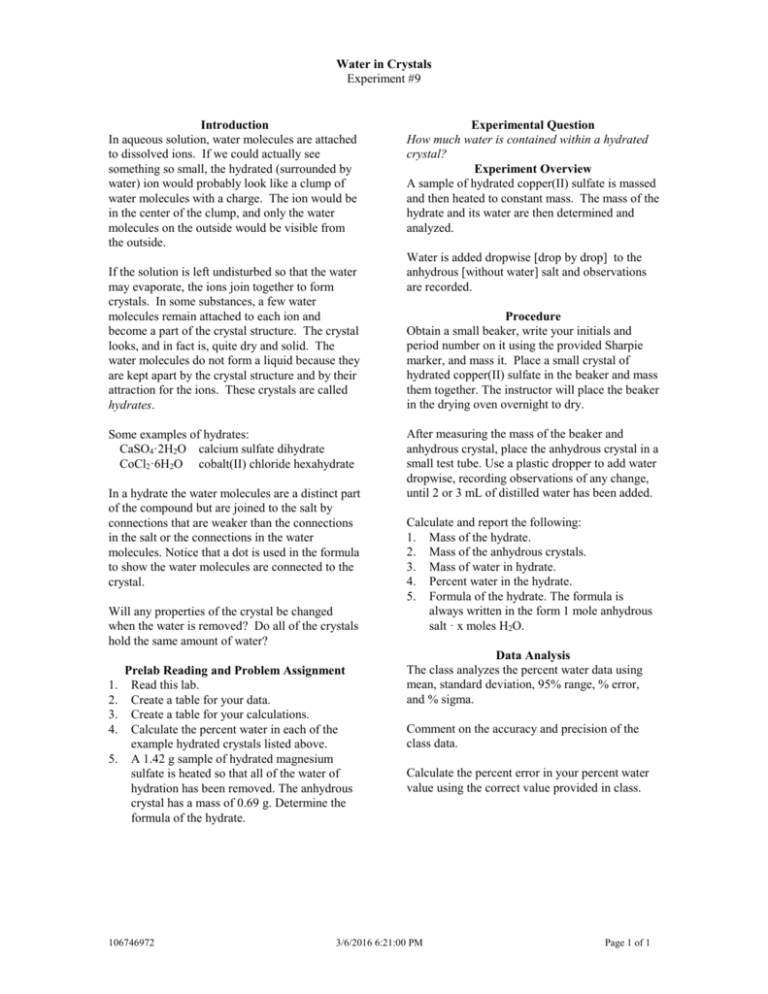09-Hydrate
advertisement

Water in Crystals Experiment #9 Introduction In aqueous solution, water molecules are attached to dissolved ions. If we could actually see something so small, the hydrated (surrounded by water) ion would probably look like a clump of water molecules with a charge. The ion would be in the center of the clump, and only the water molecules on the outside would be visible from the outside. If the solution is left undisturbed so that the water may evaporate, the ions join together to form crystals. In some substances, a few water molecules remain attached to each ion and become a part of the crystal structure. The crystal looks, and in fact is, quite dry and solid. The water molecules do not form a liquid because they are kept apart by the crystal structure and by their attraction for the ions. These crystals are called hydrates. Some examples of hydrates: CaSO4·2H2O calcium sulfate dihydrate CoCl2·6H2O cobalt(II) chloride hexahydrate In a hydrate the water molecules are a distinct part of the compound but are joined to the salt by connections that are weaker than the connections in the salt or the connections in the water molecules. Notice that a dot is used in the formula to show the water molecules are connected to the crystal. Will any properties of the crystal be changed when the water is removed? Do all of the crystals hold the same amount of water? 1. 2. 3. 4. 5. Prelab Reading and Problem Assignment Read this lab. Create a table for your data. Create a table for your calculations. Calculate the percent water in each of the example hydrated crystals listed above. A 1.42 g sample of hydrated magnesium sulfate is heated so that all of the water of hydration has been removed. The anhydrous crystal has a mass of 0.69 g. Determine the formula of the hydrate. 106746972 Experimental Question How much water is contained within a hydrated crystal? Experiment Overview A sample of hydrated copper(II) sulfate is massed and then heated to constant mass. The mass of the hydrate and its water are then determined and analyzed. Water is added dropwise [drop by drop] to the anhydrous [without water] salt and observations are recorded. Procedure Obtain a small beaker, write your initials and period number on it using the provided Sharpie marker, and mass it. Place a small crystal of hydrated copper(II) sulfate in the beaker and mass them together. The instructor will place the beaker in the drying oven overnight to dry. After measuring the mass of the beaker and anhydrous crystal, place the anhydrous crystal in a small test tube. Use a plastic dropper to add water dropwise, recording observations of any change, until 2 or 3 mL of distilled water has been added. Calculate and report the following: 1. Mass of the hydrate. 2. Mass of the anhydrous crystals. 3. Mass of water in hydrate. 4. Percent water in the hydrate. 5. Formula of the hydrate. The formula is always written in the form 1 mole anhydrous salt · x moles H2O. Data Analysis The class analyzes the percent water data using mean, standard deviation, 95% range, % error, and % sigma. Comment on the accuracy and precision of the class data. Calculate the percent error in your percent water value using the correct value provided in class. 3/6/2016 6:21:00 PM Page 1 of 1









